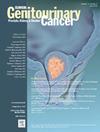淋巴血管侵袭对肾细胞癌T期前期和总生存率的影响:一项基于人群的研究。
IF 2.7
3区 医学
Q3 ONCOLOGY
引用次数: 0
摘要
淋巴血管侵袭(LVI)是肾细胞癌(RCC)公认的不良病理特征。然而,其对分期和预后的影响仍不明确,特别是在t期亚类别中。患者和方法:我们分析了来自国家癌症数据库(NCDB)的手术治疗的RCC患者,包括透明细胞、乳头状和憎色细胞RCC。检索病理t期和LVI状态的数据,以总生存期(OS)为主要终点。Kaplan-Meier曲线(KMA)和log-rank检验评估了有无LVI的t期生存差异。采用单变量和多变量Cox比例风险模型(Cox Proportional Hazard Model, xph)检验LVI与全因死亡率(All-cause Mortality, ACM)的相关性,以及LVI与t期的相互作用项。CoxPH相互作用风险比(HR)的森林图和回归线说明了LVI在t期的影响。结果:159387例RCC患者中,11.3%出现LVI。LVI与更大和更高级别的肿瘤相关,并增加了淋巴结和转移性疾病的发生率(P < 0.001)。KMA显示lvi阳性患者的5年OS明显低于lvi阴性患者(61%比85%;P < 0.001)。在T分期中,LVI赋予了“功能性优势”,T1a+LVI的生存期接近T1b, T1b+LVI类似于T2, T2+LVI接近T3, T3a+LVI反映了T3b的结果。在单变量和多变量CoxPH中,LVI是ACM的独立预测因子(P < 0.001),森林样地表明其在t期早期的相对影响最大。结论:LVI是RCC的一种侵袭性病理特征,损害了生存,特别是在低分期肿瘤中。将LVI状态纳入RCC分期可以细化风险分层,指导更密集的监测和辅助管理,特别是对早期t期疾病患者。本文章由计算机程序翻译,如有差异,请以英文原文为准。
The Influence of Lymphovascular Invasion on T Stage Upstaging and Overall Survival in Renal Cell Carcinoma: A Population-Based Study
Introduction
Lymphovascular invasion (LVI) is a recognized adverse pathological feature in renal cell carcinoma (RCC). However, its impact on staging and prognosis remains poorly defined, especially across T-stage subcategories.
Patients and Methods
We analyzed surgically treated RCC patients from the National Cancer Database (NCDB), including clear cell, papillary and chromophobe RCCs. Data on pathological T-stage and LVI status were retrieved, with overall survival (OS) as the primary outcome. Kaplan-Meier curves (KMA) and log-rank test evaluated survival differences between T-stages with and without LVI. Univariable and multivariable Cox Proportional Hazard Model (CoxPH) were fitted to test the association between LVI and All-cause Mortality (ACM) and the interaction term between LVI and T-stage. Forest plots and regression lines from the CoxPH interaction hazard ratios (HR) illustrated the impact of LVI across T-stages.
Results
Among 159,387 RCC patients, 11.3% showed LVI. LVI was associated with larger and higher‐grade tumors, and increased rates of nodal and metastatic disease (P < .001). KMA showed significantly lower 5‐year OS among LVI‐positive versus LVI‐negative patients (61% vs. 85%; P < .001). Across T stages, LVI conferred a “functional upstaging” with survival of T1a+LVI approximating T1b, T1b+LVI resembling T2, T2+LVI approximating T3, and T3a+LVI mirroring T3b outcomes. At univariable and multivariable CoxPH, LVI was an independent predictor of ACM (P < .001), with forest plots indicating its highest relative impact in earlier T-stages.
Conclusion
LVI is an aggressive pathological feature in RCC that impairs survival, especially in lower‐stage tumors. Incorporating LVI status into RCC staging may refine risk stratification and guide more intensive surveillance and adjuvant management, particularly for patients with early T-stage disease.
求助全文
通过发布文献求助,成功后即可免费获取论文全文。
去求助
来源期刊

Clinical genitourinary cancer
医学-泌尿学与肾脏学
CiteScore
5.20
自引率
6.20%
发文量
201
审稿时长
54 days
期刊介绍:
Clinical Genitourinary Cancer is a peer-reviewed journal that publishes original articles describing various aspects of clinical and translational research in genitourinary cancers. Clinical Genitourinary Cancer is devoted to articles on detection, diagnosis, prevention, and treatment of genitourinary cancers. The main emphasis is on recent scientific developments in all areas related to genitourinary malignancies. Specific areas of interest include clinical research and mechanistic approaches; drug sensitivity and resistance; gene and antisense therapy; pathology, markers, and prognostic indicators; chemoprevention strategies; multimodality therapy; and integration of various approaches.
 求助内容:
求助内容: 应助结果提醒方式:
应助结果提醒方式:


